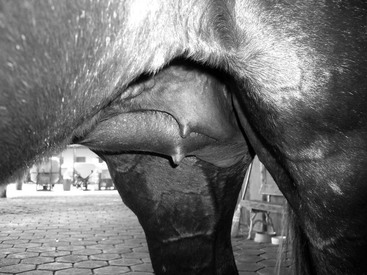Luiz Claudio Nogueira Mendes
Mammary Tumors
Mammary neoplasia in the mare is exceedingly rare, and only a few sporadic reports of mammary gland tumors in horses have been published since the first case was reported by Surmont in 1926. A prevalence of 0.11% was reported in a French study that looked at 39,800 horses at slaughter, whereas a 4-year Italian study on equine necropsy specimens from surgery or abattoirs failed to report any mammary gland tumors, and a necropsy survey of 1771 horses performed in Normandy between 1986 and 2003 reported only a single case of mammary carcinoma. A later study reported a prevalence of 1.99% in horses examined at slaughter.
Mammary neoplasia in the mare is often initially misdiagnosed as mastitis because of the similar presentation and clinical signs. It appears that equine mammary neoplasms are much more likely to be malignant than benign, and hence carry a poor prognosis for long-term survival. The most frequent diagnoses reported are carcinoma and adenocarcinoma. However, other tumors such as lymphoma, adenoma, and sarcoma (malignant fibrous histiocytoma) have been described.
Mammary Carcinoma
Equine mammary carcinomas are rare, but among cases of mammary neoplasia they have the highest prevalence. It is a condition of aged mares, generally from 12 to 25 years. The clinical signs can include painful enlargement of the mammary gland on one or both sides, palpable presence of an irregularly shaped mass or masses with a fibrous consistency, an ulcerated surface which discharges purulent material that can be fetid and sometimes blood stained, and edema of the ventral abdomen and hindlimbs. As the tumor enlarges, the mare may walk stiffly and, in advanced cases, may be in poor body condition and become prostrate. The recurring clinical characteristic of mammary carcinoma is ulceration of the skin covering the affected mammary gland.
Equine mammary carcinomas can consist of solid carcinoma, papillary ductal adenocarcinoma, and ductal carcinomas. This differentiation is made by histologic examination. All cases carry a grave prognosis because at the time of diagnosis metastases can be found in multiple organs. There is no evidence to suggest that mastectomy extends the life of affected mares.
Mammary Lymphoma
Lymphoma is the most frequently encountered neoplasm of the equine hematopoietic system and is grouped into four presentations involving primarily lymph nodes (multicentric), or extranodal sites such as skin, thymus, or alimentary tract (see Chapter 96). Anemia, hyperfibrinogenemia, and hypoalbuminemia commonly develop in horses with lymphoma. Clinical signs depend on the organ or systems affected and can be quite variable. Nonspecific signs include chronic weight loss, pyrexia, lethargy, anorexia, poor performance, peripheral lymphadenopathy, chronic colic, and diarrhea. One mare reported with mammary lymphoma had bilaterally enlarged mammary glands (Figure 101-1), which were firm, hot, and painful and had a discharge. The mucous membranes were pale, and the parotid lymph nodes enlarged. The low prevalence tends to exclude equine lymphoma from the differential diagnoses until the disease becomes chronic and the horse is unresponsive to conventional treatments.
Mammary Adenoma
Adenomas have been described in the adrenal glands, thyroid, skin, and kidneys, and in 2008, one case of mammary gland adenoma was reported. The clinical signs were left mammary enlargement and secretion of serosanguineous fluid from the teat. Palpation revealed a cylindrical firm mass with a fibrous consistency deep within the gland; the mass was not warm or mobile, and was relatively painful to palpation. Slight abduction of the left pelvic limb was noted during movement. Interestingly, the horse’s owner reported a gradual onset of disease after repeated administration of hormones to induce estrus and subsequent pregnancy.
Mammary Sarcoma
Sarcomas of the breast account for less than 1% of all human primary malignancies and, among sarcomas, malignant fibrous histiocytoma (MFH) is rare. The latter tumor has been reported in multiple locations in several domestic animal species, including the soft tissue of the neck, thigh, stifle, and forelimb of horses.
The clinical signs presented by one mare with mammary MFH included mammary gland enlargement, a palpable nodular firm mass at the base of the left teat, and a firm mass within the right mammary gland, dorsal to the right teat. Palpation of the mammary masses did not elicit a pain response from the mare, and no secretions were obtained from either teat.
Although human mammary neoplasia is common, mammary sarcomas are rare and, in general, have a poor prognosis. Human mammary sarcomas are characterized by local recurrences and visceral organ metastases, but no lymph node metastases. In horses, further study of the morphology and behavior of these neoplasms is needed.




